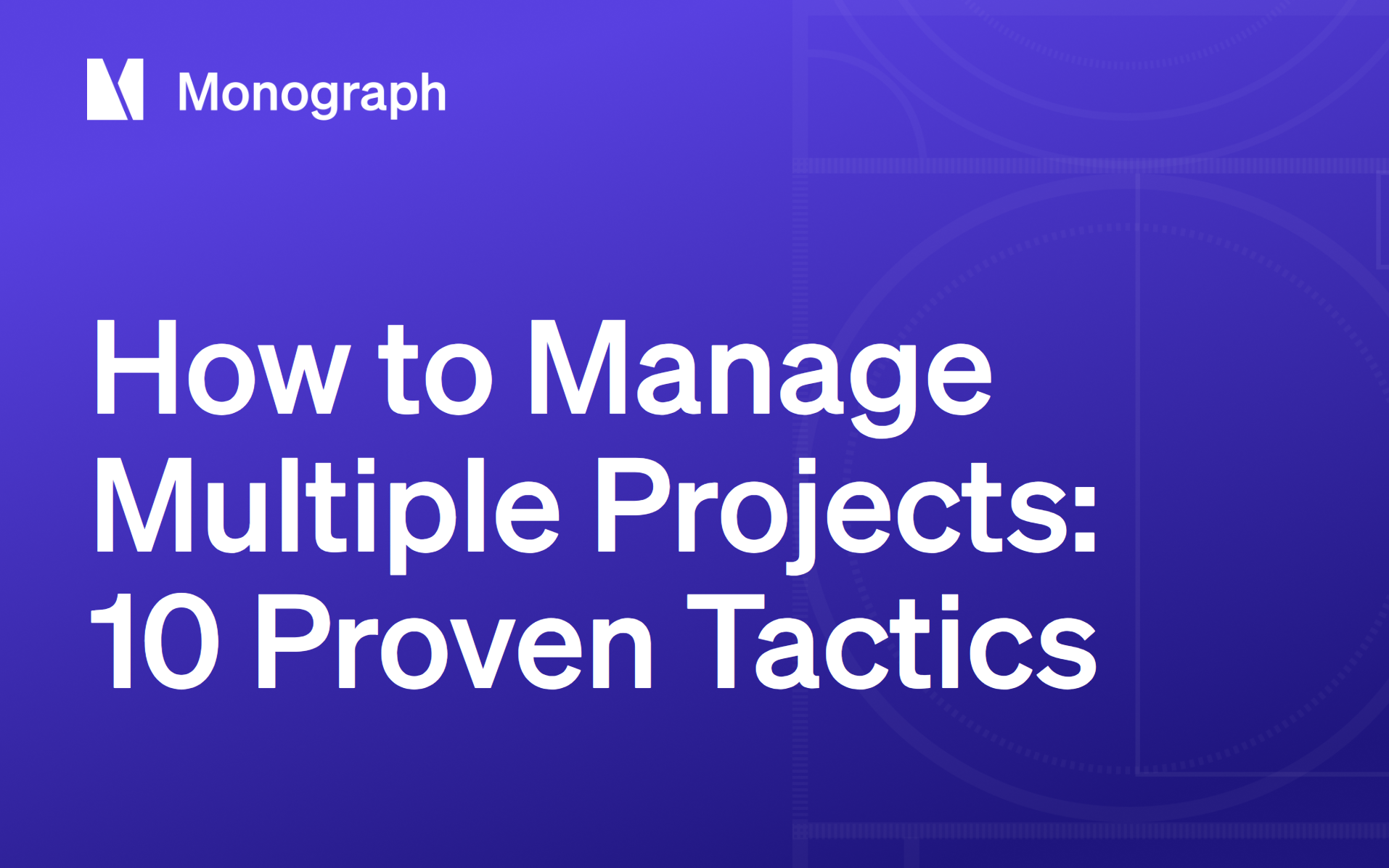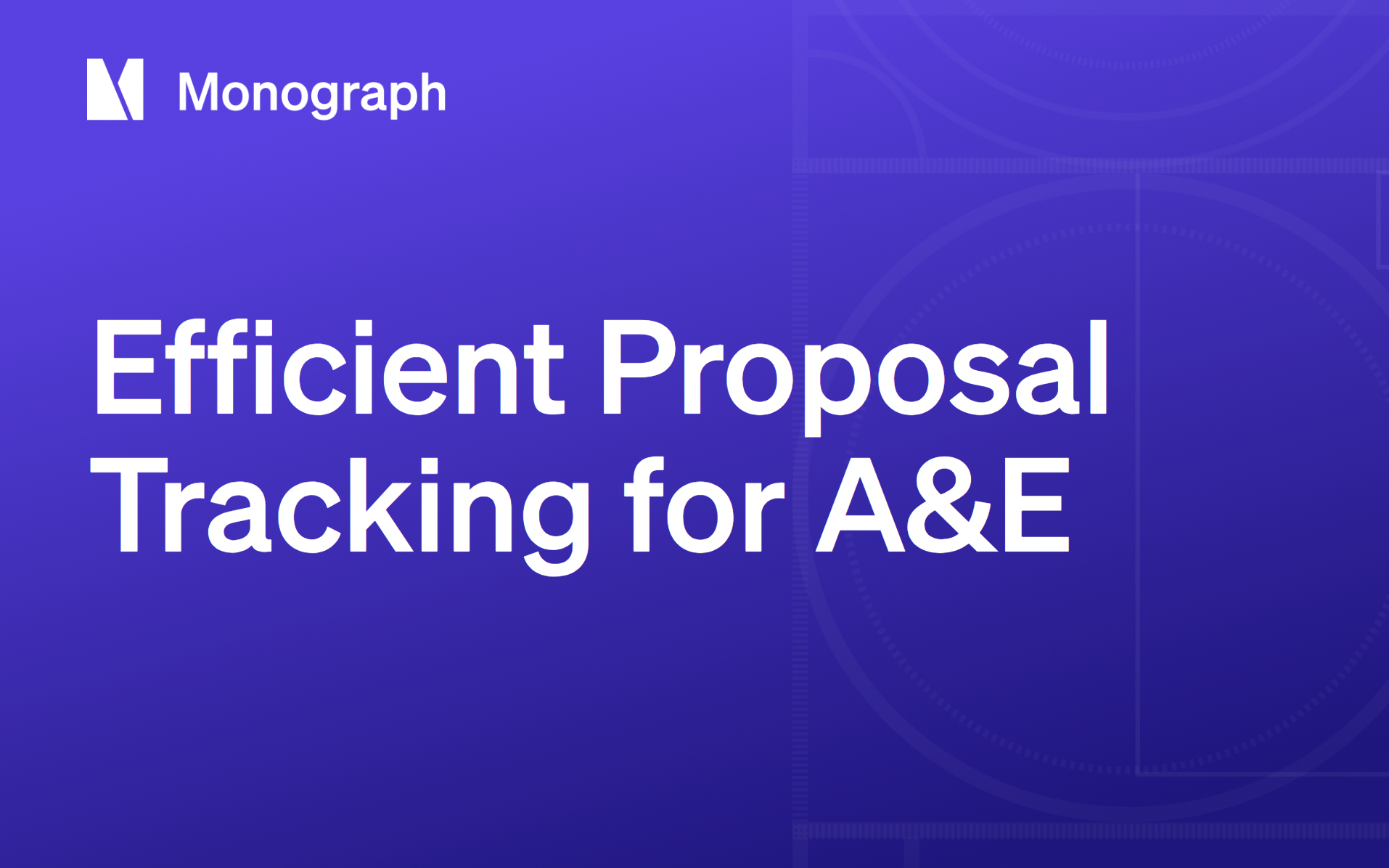Contents
Juggling five jobs in three different phases really is as hard as it feels. When schedules collide and consultants fire off RFIs at 5 p.m., you end up triaging emails instead of advancing design. Missed deadlines, over-allocated staff, and budgets that unravel faster than you can explain them to a client. These headaches show up repeatedly in A&E firms. Missed milestones routinely erode client trust and trigger costly overtime.
Scope creep piles on, too. More than half of architecture projects expand beyond their original intent, dragging fees and schedules with them.
I've been on that frantic treadmill, and I know how quickly creative energy turns into survival mode. The good news is that you can get off without sacrificing design quality or engineering rigor. The ten tactics that follow are battle-tested in studios and engineering departments just like yours. They tackle the root causes (visibility gaps, fuzzy priorities, and ad-hoc workflows) instead of papering over symptoms.
Put them to work and you'll see clear portfolio views that flag trouble early, resources balanced before burnout hits, and financial indicators that tell you (instantly) whether a project is healthy or hemorrhaging. Less stress, better margins, and more room to focus on great work; that's the payoff waiting on the other side of smarter project management.
1. Map Every Project in a Master Portfolio View
Picture yourself shuffling between a hospital addition in schematic design, a mixed-use tower waiting on permits, three tenant fit-outs racing toward construction documents, and all of them want answers today. When deadlines collide, visibility disappears first. Missed deliveries become inevitable when you're working from scattered spreadsheets and inbox threads instead of one clear dashboard.
You can't manage what you can't see. A true master portfolio view pulls every active project into a single frame, showing timelines, budgets, phase status, and fee health side by side. You'll spot over-allocated staff before burnout hits, catch a fee sprint that's outpacing scope, and flag permit delays before they derail cash flow.
We felt the pain, that’s why Monograph's Projects Overview layers each job onto one page, then overlays budget data with Monograph's MoneyGantt™ visualization so hours, dollars, and milestones live in the same place. Instead of chasing updates, you glance once and know exactly where conflicts lurk, which teams have capacity, and how to explain the story to clients or principals. Centralized visibility transforms multiple projects from chaos into coordinated progress.
2. Prioritize Projects Against Firm Goals
When every project feels equally urgent, nothing gets the attention it deserves. Three projects compete for the same engineer while permit revisions on a life-safety job sit untouched. The loudest client wins, deadlines slip, and profit margins shrink. Treating everything as top priority spreads your team thin and kills profitability.
Smart ranking cuts through that chaos. Project prioritization frameworks force leadership consensus on what matters most:
- The Analytic Hierarchy Process scores projects against weighted criteria, reducing gut feeling and personal bias
- The Project Prioritization Matrix plots benefit against effort for clear "quick wins vs. resource drains" visibility
- The MoSCoW method sorts your backlog into clear tiers during a single team meeting
These frameworks work best when customized to A&E work, weighted around what actually drives firm success: life-safety deadlines, public hearing schedules, strategic clients, and fee health.
For A&E work, weight your scoring around what actually drives firm success: life-safety deadlines, public hearing schedules, strategic clients, and fee health. A simple template assigns 1–5 points to each project for deadline urgency, profit potential, strategic value, and resource requirements. Total the scores and you get an objective ranking that survives the next crisis call from a client.
Monograph turns those scores into action. Filter your project list by profit potential, sort by approaching deadlines, or spotlight strategic clients with a single click, no spreadsheet hunting required. The result is a data-driven work queue that keeps everyone focused on firm goals, not whoever complains the loudest.
3. Break Down Scope into Phase-Based Plans
If you try to manage a skyscraper from one giant drawing set, disaster follows. The same holds for project management. Compressing an entire job into a single line item wrecks visibility and budgets. Breaking scope into industry-standard phases creates manageable checkpoints that function like well-placed expansion joints, not afterthoughts.
Most A&E teams use a six-stage model:
- Pre-design: Capture goals and zoning constraints
- Schematic Design: Focus on massing studies and concept development
- Design Development: Refine systems and coordinate disciplines
- Construction Documentation: Achieve absolute precision for contractor pricing
- Bidding: Manage contractor selection and value engineering
- Construction Administration: Oversee field implementation and change management
This structure reflects how work and risk naturally evolve, creating clear handoffs between phases.
Treating each phase as its own mini-project with clear deliverables, milestones, and dedicated budgets creates accountability. Formal reviews before moving forward give you the chance to spot fee creep and realign resources. I allocate dollars per phase up front, then adjust at every handoff, similar to how you'd refine a load path when new forces appear.
Monograph's Project Planner handles the heavy lifting by auto-generating phase schedules and budgets from signed contracts. That automation links directly to Monograph's MoneyGantt™ so you see, in real time, how hours logged in Design Development impact the overall fee. The payoff: clients know exactly what's coming next, cash flow steadies because invoices track phase completion, and your team tackles each stage with purpose instead of firefighting.
4. Standardize Reusable Workflows and Templates
When you're flipping between five active jobs, every missing detail drags your brain back to square one. Standardized workflows eliminate that mental back-and-forth, automating repeatable steps to cut manual data entry, shorten approvals, and prevent avoidable mistakes. Centralized processes keep architects, engineers, and consultants working from the same set of drawings and decisions.
Start with the templates you touch daily:
- Fee structure worksheets tied to standard phase breakdowns
- Milestone schedules with built-in phase gates and review periods
- RFI and change-order logs with automatic routing and approval workflows
- Submittal registers that track vendor responses and architect reviews
- Design review checklists that ensure nothing falls through the cracks
These documents appear on every project, carry low creative risk, and cause high pain when they go wrong.
Lock the format, embed required fields, and version-control them in a shared workspace. You'll free your team to focus on solving design problems instead of reinventing forms.
Monograph turns those proven setups into living templates. Copy a past project, adjust scope, and every phase budget, task list, and checklist rolls forward in minutes. The payoff shows up fast: quicker kickoffs, smoother onboarding for new hires, and a client experience that feels consistent whether they're building a lobby remodel or a $200-million tower.
5. Allocate Resources Weekly, and Rebalance Often
A single mis-scheduled week can wreck an entire month, which is why month-long staffing plans break down so quickly in A&E work. Projects shift phases, permits stall, a client suddenly needs a redesign, yet the spreadsheet you built three weeks ago stays frozen in time. The result is predictable: overextended staff create bottlenecks, quality suffers, and burnout follows.
Treat resource planning like structural load analysis: check the loads frequently and redistribute before something buckles. Weekly staffing plans hit the right cadence, you commit people to projects every Monday, then revisit mid-week when the inevitable curveball lands. Target 75–85% billable utilization; anything higher courts fatigue, anything lower leaves money on the table.
Monograph's capacity dashboard shows workload by staff, phase, and project in a single view. When someone spikes above 85%, shift hours to a teammate or slide a non-critical deadline before stress turns into overtime. Keep the ritual simple: Monday morning brings 15 minutes with project leads to lock the week's assignments, Thursday afternoon offers a quick stress test to surface new priorities and rebalance. Because the conversation happens every week, your team knows it's coming, speaks up early, and heads into the weekend confident that no one is silently drowning.
6. Track Time in Real Time, Not After the Fact
Another Friday, another scramble to reconstruct where the last 40 hours went. Those retro-active guesses don't just pad admin time, they blur the very data you rely on to keep projects profitable. In A&E firms, missed or late entries cascade into larger issues: inaccurate fee burn reports, muddled billable-vs-non-billable ratios, and ultimately the kind of deadline slips that erode client confidence and invite penalties.
Logging hours as you work flips that script. Real-time data shows you the exact moment a phase starts drifting, giving you space to course-correct before costs snowball. Think of it like checking structural deflection during a load test; you don't wait until the beam fails to take a measurement.
To make daily tracking stick, treat it as a design detail worth refining:
- Strip the interface to essentials: project, phase, and a short note
- Give everyone mobile access so field visits and site walks get captured on the spot
- Limit categories because the fewer choices, the fewer excuses
This approach removes friction while maintaining the data quality you need for accurate project analysis.
Monograph helps by auto-assigning your planned tasks to the day's timesheet and pinging you when entries are missing. That gentle nudge means invoices go out faster, which tightens cash flow and keeps your team focused on design instead of debt collection. Creative teams often resist time sheets because they feel like micromanagement. Reframe it as authorship: accurate hours tell the real story of the work and protect the value of your expertise. Pair that mindset with weekly shout-outs for on-time entries, and you'll see compliance climb without heavy policing.
7. Centralize Communication and Documentation
Jumping between email threads, chat pings, and half-buried PDFs creates chaos. One missed RFI derails schedules, triggers costly rework, and creates the communication breakdowns that plague A&E projects when information scatters across systems your team outgrew years ago.
The fix is a single source of truth. Housing every RFI, meeting minute, client comment, and consultant sketch in one workspace where context connects to conversations eliminates the "Did you see my email?" cycle that slows progress. Centralized workflows give everyone (from junior designer to structural sub-consultant) immediate access to the latest drawings and decisions.
Establish a clear information hierarchy. Urgent design clarifications live in the project feed, contractual questions stay in the RFI log, and long-form decisions reside in phase folders. When each channel has a defined purpose, chatter drops and accountability rises. Digital workflows that map documents to phases reduce hunting time and preserve historical context.
Monograph ties every discussion and file directly to the Monograph's MoneyGantt™ timeline, so you can click any milestone and see the conversations, decisions, and drawings that shaped it. The result: fewer surprises, faster approvals, and a complete project history you can trust when audits (or lawsuits) arrive.
8. Delegate with Clarity, Not Micromanagement
When you're running five active jobs, the easiest way to choke progress is keeping every decision on your desk. Poor delegation turns resource allocation into a traffic jam, talent sits idle while you race to approve details, and deadlines slip. Bottlenecks created by over-extended project leads are a root cause of missed milestones and staff burnout in A&E firms.
Clear delegation flips that script. Before handing off work, establish four non-negotiables:
- Assign a single responsible owner for accountability
- Set an unambiguous deadline that accounts for dependencies
- Define the deliverable so everyone knows what "done" looks like
- Establish a measurable success metric (hours, dollars, or quality targets)
These elements create clarity while preserving autonomy for your team members.
Delegate tasks when the path is straightforward (draft sheets, update a model, issue an RFI). Delegate outcomes when you need broader judgment ("own schematic design through client sign-off"). The first approach frees your time and the second develops future leaders. A junior architect can manage door schedules. A rising project engineer can shepherd value-engineering options through approval.
Match assignments to both current skill level and growth trajectory. With Monograph, staffing decisions connect directly to phase budgets, so the hours you assign instantly update fee burn and capacity views across all projects, no separate spreadsheet gymnastics required. Stay informed without hovering through ten-minute daily stand-ups and mid-week dashboard reviews. This balance removes bottlenecks, protects budgets, and creates space to tackle the next challenge instead of rehashing work you've already handed off.
9. Monitor Leading Financial Indicators Daily
Treat your project finances like a structural load analysis: if you wait a month to run the numbers, the cracks have already formed. Three signals matter most in an A&E firm: fee burn rate (how fast you're spending the agreed fee), planned-vs-logged hours (the gap between the schedule and reality), and realization rate (the percentage of logged hours you can actually bill). Each changes every time someone submits a timesheet, so relying on end-of-month reports is as risky as checking steel connections after the concrete is poured.
Start each day with a ten-minute financial check. Open Monograph's MoneyGantt™ and scan the real-time budget widgets: green means fees are tracking, amber signals you're within 10% of the limit, red tells you to act now. Compare yesterday's logged hours against the plan. A sudden spike on one phase usually means scope drift or misallocation; either way, it calls for a quick huddle before lunch. Finally, glance at realization. If that percentage slips for more than two days in a row, tighten the task list or renegotiate with the client before the loss compounds.
Set thresholds that trigger notifications, not fire drills. For most firms, a 75-85% utilization target keeps staff productive without burning them out, while a 90% fee burn alert forces a decision: rebalance resources or reset expectations. By catching issues while they're still indicators (not outcomes) you pivot early, protect profit, and keep every project on solid footing.
10. Automate Reporting and Billing Cycles
You already feel the pinch every month: digging through spreadsheets, chasing missing timesheets, and formatting invoices that clients still send back for revisions. Manual reporting and billing devour hours you could spend on design or technical review. Automation is the structural upgrade that eliminates those weak joints.
Start with the highest-frequency culprits. Weekly status reports, draft invoices, and expense logs. When these move through a digital workflow instead of email attachments, you eliminate redundant data entry and the inevitable copy-paste errors. AEC firms that embrace workflow automation cut hand-off time dramatically because information flows directly from time tracking to billing without human reformatting. Automated templates apply the same rules every time, eliminating missed billable hours and the rounding mistakes that spark awkward client calls. As workflow research shows, fewer manual touches mean fewer surprises.
Pick one recurring report, build a template, and run it alongside your manual process for a cycle or two. Verify the numbers, adjust, then move to the next report. Once your team trusts the outputs, turn on automatic invoice generation. In Monograph, approved timesheets become draft invoices while payment sync keeps your books current, no late-night exports, no double entry.
The results show up immediately: fewer administrative hours each week, invoices out the door days earlier, and cash in the bank before the next payroll run. Automating the paperwork doesn't just save time; it gives you back the headspace to focus on the work that wins projects and grows the firm.
Manage Multiple Projects With Monograph
Managing multiple projects doesn't need to feel like you're drafting in the dark. When you map every job in a master portfolio, rank work against firm goals, plan by phase, standardize workflows, recalibrate resources weekly, track time as it happens, centralize conversations, delegate with precision, watch leading financial indicators, and automate reporting, each tactic reinforces the next. The result is a system as coherent as a well-coordinated drawing set.
Start by auditing one project against these ten moves. Where are the blind spots? Which process creates the most friction? Fix that first, then layer in the rest. You'll see momentum build quickly because every improvement frees up bandwidth for the next.
Architecture and engineering firms using Monograph report significant improvements: 25% less administrative time, faster billing processes, and better project margins. These results come from having the right system in place.
Looking for project management software that handles multiple projects without the chaos? Switch to Monograph.
Frequently Asked Questions
How long does it take to see results from implementing these project management tactics?
Most firms see immediate improvements in visibility and organization within the first week. Measurable results like improved utilization rates and faster billing typically appear within 30-60 days as teams adapt to new workflows.
Can these tactics work for firms that use different project phases than the standard six-stage model?
Absolutely. The key principle is breaking work into manageable chunks with clear deliverables. Whether you use AIA phases, custom phases, or discipline-specific workflows, the same visibility and planning benefits apply.
What's the biggest mistake firms make when trying to manage multiple projects?
A: Trying to track everything in their heads or relying on ad-hoc spreadsheets. Without centralized visibility, small problems compound quickly. The second biggest mistake is treating every project with equal priority instead of ranking based on strategic value and deadlines.
How do you handle unexpected scope changes when managing multiple projects?
A: Real-time financial tracking is crucial. When scope changes hit one project, you can immediately see the impact on resources and deadlines across your entire portfolio. This lets you rebalance quickly rather than discovering problems weeks later during monthly reviews.
Is it worth investing in project management software for smaller firms?
A: Yes, especially for firms juggling 3+ active projects. The cost of missed deadlines, budget overruns, or inefficient billing cycles typically exceeds software costs within months. The key is choosing a platform designed for A&E workflows rather than generic project management tools.





